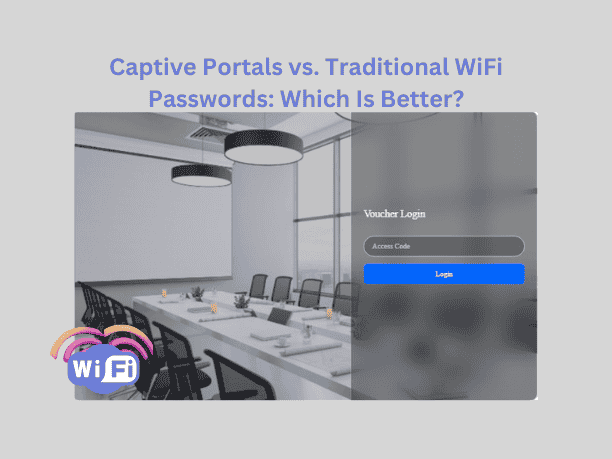In today’s connected world, providing secure and user-friendly internet access is more important than ever. Whether you’re managing a café, hotel, school, or office, choosing between a captive portal and a traditional WiFi password can significantly impact both user experience and WiFi security. But which option is the better fit for your environment? Let’s dive into a detailed comparison to help you make the best decision.
Understanding Captive Portals
To begin with, a captive portal is a web-based gateway that appears when a user first connects to a WiFi network. Before gaining full internet access, the user is typically required to take an action—such as entering an email address, logging in with a username, accepting terms and conditions, or even watching an ad.
Captive portals are widely used in public WiFi environments like airports, hotels, and restaurants. In many cases, businesses also use them to collect customer data, manage access duration, and promote special offers. As a result, they are often favored for environments where guest WiFi management and marketing integration are key priorities.
Understanding Traditional WiFi Passwords
On the other hand, a traditional WiFi password offers a much simpler access method. Users only need to enter a single shared password to connect to the wireless network. This method is especially common in homes and small offices, where ease of use and speed are prioritized over access control or data collection.
Although traditional passwords are easy to set up and use, they come with certain limitations. For example, they lack individual user tracking and can be easily shared or leaked, which may compromise WiFi network security over time.
Key Differences: Captive Portal vs. WiFi Password
Now that we’ve covered the basics, let’s compare the two methods side by side. Both offer distinct advantages and drawbacks, depending on your specific needs.
Feature Captive Portal Traditional WiFi Password
Security Moderate to High Low to Moderate
User Access Control Individualized Shared
Marketing Potential High (custom splash pages) None
Data Collection Yes (emails, analytics) No
Ease of Use Moderate Very Easy
Setup Complexity Medium to High Low
Best For Public, guest, and business WiFi Home and small office WiFi
Clearly, the captive portal shines when detailed control and user analytics are important. Meanwhile, the traditional WiFi password is ideal when simplicity and speed are more critical.

Advantages of Using Captive Portals
First and foremost, captive portals provide a higher level of control. Because each user can be required to log in or accept terms, businesses can easily manage bandwidth, limit session time, and ensure compliance with usage policies.
Moreover, captive portals offer unique marketing opportunities. For instance, businesses can display promotions, gather user information, or even enable social media logins. This not only improves guest WiFi experience, but also helps in building customer loyalty.
In addition, using a captive portal helps you track network activity, which is particularly valuable in high-traffic areas or locations where compliance and accountability are crucial.
Drawbacks of Captive Portals
Despite their benefits, captive portals aren’t perfect. For starters, the setup can be more complex, often requiring a specialized router, access point, or third-party software. Furthermore, some users may find the extra step inconvenient—especially if they’re in a hurry.
Another consideration is that certain devices, such as smart TVs, printers, or game consoles, may not interact well with captive portals. Therefore, you might need to allow MAC address whitelisting or provide a separate access method for those devices.
Advantages of Traditional WiFi Passwords
Alternatively, traditional WiFi passwords offer simplicity. They are incredibly easy to configure and require no special software or login pages. Users simply enter the password and are connected within seconds.
Additionally, this method is ideal for smaller environments where the risks are lower, such as homes or small offices. Since there’s no need to manage sessions or user credentials, it allows for a hassle-free WiFi experience.
Drawbacks of Traditional Passwords
Nevertheless, traditional WiFi passwords come with significant security concerns. Because the password is usually shared among multiple users, it can easily be leaked or misused. Moreover, there is no way to know who is connected, how long they’ve been connected, or what they’re doing online.
As your user base grows, it becomes increasingly difficult to maintain WiFi security and control access effectively.
Which Is Better for Your Network?
Ultimately, choosing between a captive portal and a traditional WiFi password depends on your specific needs.
Choose a captive portal if you want better security, guest access control, data collection, or promotional opportunities. This method is ideal for hotels, restaurants, educational institutions, and any public WiFi network.
Choose a traditional WiFi password if you need a quick, simple setup for a small number of users in a secure environment, such as a private home or a small office.
Final Verdict: Captive Portals Win for Public Networks
In conclusion, while both methods have their strengths, captive portals offer far more flexibility, control, and business value—especially in public or guest-facing environments. They not only enhance WiFi password security, but also provide insights, marketing potential, and regulatory compliance.
However, if you’re looking for a straightforward and fast connection for just a few users, a traditional password might still be your best bet.
captive portal, traditional WiFi password, public WiFi, guest WiFi, WiFi password security, network access control, splash page, WiFi login portal, wireless security, guest internet access.
Would you like a version of this post tailored to a specific industry like hospitality, education, or healthcare?
